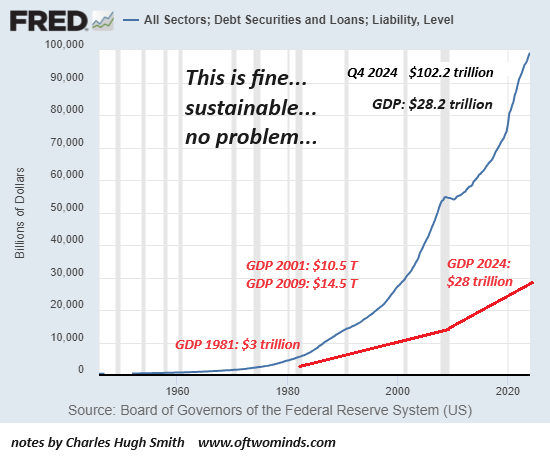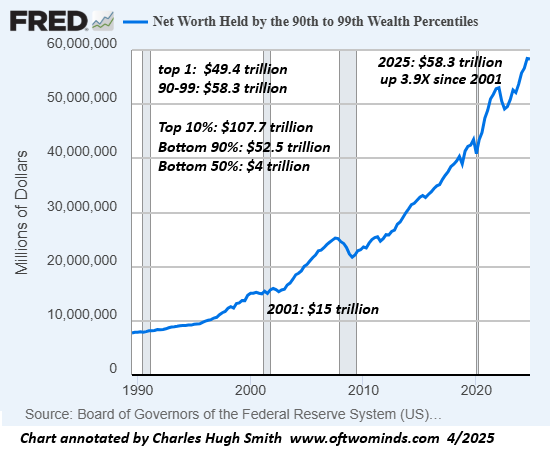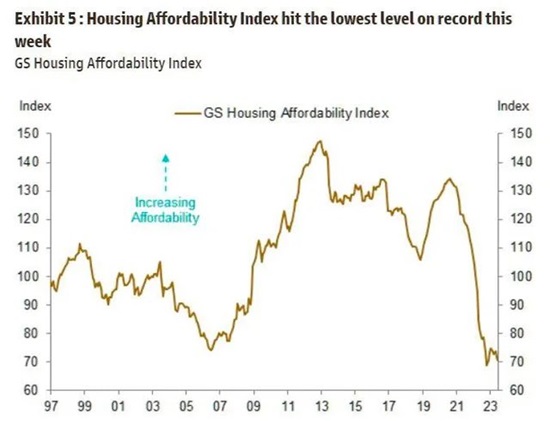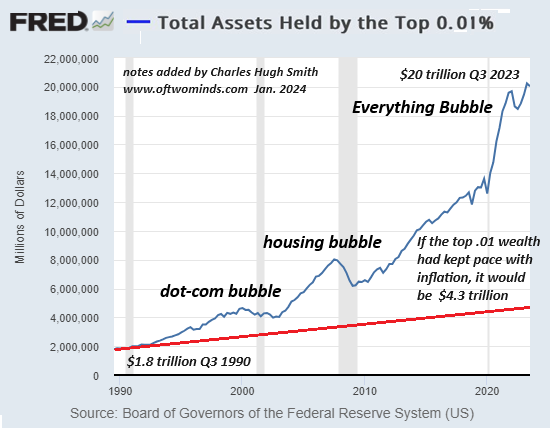Substituting debt for earnings while enriching the rich will bear bitter fruit.
Climbing above the craziness of the Normalized Now news flow to view the economy from a quiet, windswept peak helps clear the mind of clutter. The entire economy–and its future–can be distilled down to four charts that tell the underlying story of the U.S. economy over the past 55 years.
Many of the thousands of charts floating around illuminate some aspect of the economy, but these four tell the primary story:
1. The gains from rising productivity–the only durable source of prosperity–were shifted from wages to owners of capital.
2. As wages lost ground, the central bank (Federal Reserve) replaced cash earnings with debt, by a) lowering interest rates for 40 years, b) increasing the money supply and c) opening the flood gates of credit.
3. Wage earners used credit to pay expenses, the wealthy used credit to buy income-producing assets.
4. As a result, assets such as houses are now unaffordable to all but the wealthy.
The net result of these dynamics is the rich got much, much richer, and wage earners became debt-serfs paying interest to the wealthy owners of their debts. Let’s start by noting the difference between an owner-occupied house and an asset (for example a rental property) that generates income.
The owner-occupied house may appreciate in value over time, but this increase isn’t income or a capital gain until the house is sold. Until that point of sale, the house is merely an expense.
Student loans, auto loans, credit cards, etc. are also expenses. Wage earners’ debts are expenses that aren’t offset by income generated by the “asset” purchased with credit.
The quibble here is a $100,000 student loan will “pay off” by increasing the earnings of the student debtor, but this is not the equivalent of buying a bond that pays guaranteed interest. The university diploma may or may not pay off, or it may pay off for a few years and then become a net liability. It’s more a wager than an investment, regardless of what the Higher Education / Student Loan industry claim.
The wealthy who already own assets have a much deeper pool of credit to tap, and the cost of borrowing money is lower for them, too. So the wealthy tapped the expanding pool of “money” and credit to buy income-producing assets: stocks, real estate, enterprises, etc.
Given the limited quantity of real-world assets that generate income, this relentless credit-fueled demand from the wealthy pushed the valuations of assets higher, rendering them less affordable to wage earners.
This massive, sustained transfer of wealth via credit expansion has been going on so long that it’s now normalized: very few people can recall an economy that shared the gains with wage earners rather than diverting most of the nation’s wealth to the already-wealthy.
This chart of wages’ share of the nation’s income is the key snapshot of the economy’s core dynamic. No, it’s not tech, or the stock market, it’s this systemic shift of income from wage earners to owners of capital.
Over the past 50 years, this transfer amounts to a staggering $150 trillion: (same chart, but with the FRED database link)
Here is the chart of total credit expansion, which has outpaced not just wages but (gross domestic product): 
This chart of the top 9% (the top 1% have their own chart) shows how the rich have become much richer. The top 10% (top 9% plus the top 1%) have a net worth of $108 trillion, double that of the bottom 90% ($52 trillion), and 27X the net worth of the bottom 50% of the populace ($4 trillion). 
The net result is housing has shifted from being affordable to wage earners seeking a place to live to an asset snapped up by the wealthy, private equity and corporations: since wage earners have lost ground, they cannot possibly compete with the wealthy in a bidding war funded by bottomless credit lines. Housing is now unaffordable except to the wealthy. 
As a lagniappe, here is a chart of the wealth held by the top 0.01%, which illustrated how the wealth piling up in the top 10% has aggregated in the top 1%, top 0.1% and top 0.01%.

What future do these charts forecast? Instability on a scale few believe possible in the Normalized Now of $100 million homes, $600 million yachts and the speculative frenzy arising as those left behind seek some long-shot wager to gain a bit of the ground that has been lost over 2+ generations.
Substituting debt for earnings while enriching the rich will bear bitter fruit. How it manifests is unknowable, but that it will manifest is predictable. Extremes become more extreme until they break the entire status quo into brittle shards.
